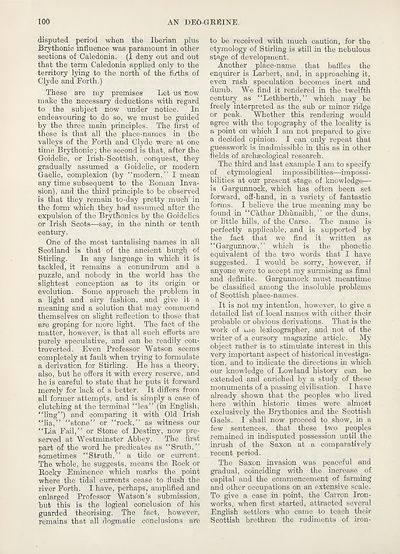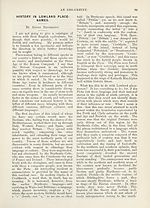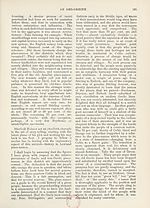An Comunn Gàidhealach Publications > Deo-gréine > Volume 17, October 1921 to September 1922
(108) Page 100
Download files
Complete book:
Individual page:
Thumbnail gallery: Grid view | List view

100
AN DEO-GMNE.
disputed period when the Iberian plus
Brythonic influence was paramount in other
sections of Caledonia. (I deny out and out
that the term Caledonia applied only to the
territory lying to the north of the firths of
Clyde and Forth.)
These are my premises Let us now
make the necessary deductions with regard
to the subject now under notice. In
endeavouring to do so, we must be guided
by the three main principles. The first of
these is that all the place-names in the
valleys of the Forth and Clyde were at one
time Brythonic; the second is that, after the
Goidelic, or Irish-Scottish, conquest, they
gradually assumed a Goidelic, or modern
Gaelic, complexion (by “modern,” I mean
any time subsequent to the Roman Inva¬
sion), and the third principle to be observed
is that they remain to-day pretty much in
the form which they had assumed after the
expulsion of the Brythonics by the Goidelics
or Irish Scots—say, in the ninth or tenth
century.
One of the most tantalising names in all
Scotland is that of the ancient burgh of
Stirling. In any language in which it is
tackled, it remains a conundrum and a
puzzle, and nobody in the world has the
slightest conception as to its origin or
evolution. Some approach the problem in
a light and airy fashion, and give it a
meaning and a solution that may commend
themselves on slight reflection to those that
are groping for more light. The fact of the
matter, however, is that all such efforts are
purely speculative, and can be readily con¬
troverted. Even Professor Watson seems
completely at fault when trying to formulate
a derivation for Stirling. He has a theory,
also, but he offers it with every reserve, and
he is careful to state that he puts it forward
merely for lack of a better. It differs from
all former attempts, and is simply a case of
clutching at the terminal “lea” (in English,
“ling”) and comparing it with Old Irish
“lia,” “stone” or “rock,” as witness our
“Lia Fail,” or Stone of Destiny, now pre¬
served at Westminster Abbey. The first
part of the word he predicates as “Sruth,”
sometimes “Struth,” a tide or current.
The whole, he suggests, means the Rock or
Rocky Eminence which marks the point
where the tidal currents cease to flush the
river Forth. I have, perhaps, amplified and
enlarged Professor Watson’s submission,
but this is the logical conclusion of his
guarded theorising. The fact, however,
remains that all dogmatic conclusions are
to be received with much caution, for the
etymology of Stirling is still in the nebulous
stage of development.
Another place-name that baffles the
enquirer is Larbert, and, in approaching it,
even rash speculation becomes inert and
dumb. We find it rendered in the twelfth
century as “Lethberth,” which may be
freely interpreted as the sub or minor ridge
or peak. Whether this rendering would
agree with the topography of the locality is
a point on which I am not prepared to give
a decided opinion. I can only repeat that
guesswork is inadmissible in this as in other
fields of archseological research.
The third and last example I am to specify
of etymological impossibilities—^impossi¬
bilities at our present stage of knowledge—
is Gargunnock, which has often been set
forward, off-hand, in a variety of fantastic
forms. I believe the true meaning may be
found in “Cathar Dhimaibh,” or the duns,
or little hills, of the Carse. The name is
perfectly applicable, and is supported by
the fact that we find it written as
“Gargunnow, ” which is the phonetic
equivalent of the two words that I have
suggested. I would be sorry, however, if
anyone were to accept my surmising as final
and definite. Gargunnock must meantime
be classified among the insoluble problems
of Scottish place-names.
It is not my intention, however, to give a
detailed list of local names with either their
probable or obvious derivations. That is the
work of wie lexicographer, and not of the
writer of a cursory magazine article. My
object rather is to stimulate interest in this
very important aspect of historical investiga¬
tion, and to indicate the directions in which
our knowledge of Lowland history can be
extended and enriched by a study of these
monuments of a passing civilisation. I have
already shown that the peoples who lived
here within historic times were almost
exclusively the Brythonics and the Scottish
Gaels. I shall now proceed to show, in a
few sentences, that these two peoples
remained in indisputed possession until the
inrush of the Saxon at a comparatively
recent period.
The Saxon invasion was peaceful and
gradual, coinciding with the increase of
capital and the commencement of farming
and other occupations on an extensive scale.
To give a case in point, the Carron Iron¬
works, when first started, attracted several
English settlers who came to teach their
Scottish brethren the rudiments of iron-
AN DEO-GMNE.
disputed period when the Iberian plus
Brythonic influence was paramount in other
sections of Caledonia. (I deny out and out
that the term Caledonia applied only to the
territory lying to the north of the firths of
Clyde and Forth.)
These are my premises Let us now
make the necessary deductions with regard
to the subject now under notice. In
endeavouring to do so, we must be guided
by the three main principles. The first of
these is that all the place-names in the
valleys of the Forth and Clyde were at one
time Brythonic; the second is that, after the
Goidelic, or Irish-Scottish, conquest, they
gradually assumed a Goidelic, or modern
Gaelic, complexion (by “modern,” I mean
any time subsequent to the Roman Inva¬
sion), and the third principle to be observed
is that they remain to-day pretty much in
the form which they had assumed after the
expulsion of the Brythonics by the Goidelics
or Irish Scots—say, in the ninth or tenth
century.
One of the most tantalising names in all
Scotland is that of the ancient burgh of
Stirling. In any language in which it is
tackled, it remains a conundrum and a
puzzle, and nobody in the world has the
slightest conception as to its origin or
evolution. Some approach the problem in
a light and airy fashion, and give it a
meaning and a solution that may commend
themselves on slight reflection to those that
are groping for more light. The fact of the
matter, however, is that all such efforts are
purely speculative, and can be readily con¬
troverted. Even Professor Watson seems
completely at fault when trying to formulate
a derivation for Stirling. He has a theory,
also, but he offers it with every reserve, and
he is careful to state that he puts it forward
merely for lack of a better. It differs from
all former attempts, and is simply a case of
clutching at the terminal “lea” (in English,
“ling”) and comparing it with Old Irish
“lia,” “stone” or “rock,” as witness our
“Lia Fail,” or Stone of Destiny, now pre¬
served at Westminster Abbey. The first
part of the word he predicates as “Sruth,”
sometimes “Struth,” a tide or current.
The whole, he suggests, means the Rock or
Rocky Eminence which marks the point
where the tidal currents cease to flush the
river Forth. I have, perhaps, amplified and
enlarged Professor Watson’s submission,
but this is the logical conclusion of his
guarded theorising. The fact, however,
remains that all dogmatic conclusions are
to be received with much caution, for the
etymology of Stirling is still in the nebulous
stage of development.
Another place-name that baffles the
enquirer is Larbert, and, in approaching it,
even rash speculation becomes inert and
dumb. We find it rendered in the twelfth
century as “Lethberth,” which may be
freely interpreted as the sub or minor ridge
or peak. Whether this rendering would
agree with the topography of the locality is
a point on which I am not prepared to give
a decided opinion. I can only repeat that
guesswork is inadmissible in this as in other
fields of archseological research.
The third and last example I am to specify
of etymological impossibilities—^impossi¬
bilities at our present stage of knowledge—
is Gargunnock, which has often been set
forward, off-hand, in a variety of fantastic
forms. I believe the true meaning may be
found in “Cathar Dhimaibh,” or the duns,
or little hills, of the Carse. The name is
perfectly applicable, and is supported by
the fact that we find it written as
“Gargunnow, ” which is the phonetic
equivalent of the two words that I have
suggested. I would be sorry, however, if
anyone were to accept my surmising as final
and definite. Gargunnock must meantime
be classified among the insoluble problems
of Scottish place-names.
It is not my intention, however, to give a
detailed list of local names with either their
probable or obvious derivations. That is the
work of wie lexicographer, and not of the
writer of a cursory magazine article. My
object rather is to stimulate interest in this
very important aspect of historical investiga¬
tion, and to indicate the directions in which
our knowledge of Lowland history can be
extended and enriched by a study of these
monuments of a passing civilisation. I have
already shown that the peoples who lived
here within historic times were almost
exclusively the Brythonics and the Scottish
Gaels. I shall now proceed to show, in a
few sentences, that these two peoples
remained in indisputed possession until the
inrush of the Saxon at a comparatively
recent period.
The Saxon invasion was peaceful and
gradual, coinciding with the increase of
capital and the commencement of farming
and other occupations on an extensive scale.
To give a case in point, the Carron Iron¬
works, when first started, attracted several
English settlers who came to teach their
Scottish brethren the rudiments of iron-
Set display mode to:
![]() Universal Viewer |
Universal Viewer | ![]() Mirador |
Large image | Transcription
Mirador |
Large image | Transcription
| An Comunn Gàidhealach > An Comunn Gàidhealach Publications > Deo-gréine > Volume 17, October 1921 to September 1922 > (108) Page 100 |
|---|
| Permanent URL | https://digital.nls.uk/127171269 |
|---|
| Description | Leabhar 17, Treasamh Mios an Fhoghair 1921 gu Dara Mìos an Fhoghair 1922 |
|---|---|
| Attribution and copyright: |
|
| Description | This contains items published by An Comunn, which are not specifically Mòd-related. It includes journals, annual reports and corporate documents, policy statements, educational resources and published plays and literature. It is arranged alphabetically by title. |
|---|
| Description | A collection of over 400 items published by An Comunn Gàidhealach, the organisation which promotes Gaelic language and culture and organises the Royal National Mòd. Dating from 1891 up to the present day, the collection includes journals and newspapers, annual reports, educational materials, national Mòd programmes, published Mòd literature and music. |
|---|---|
| Additional NLS resources: |
|

